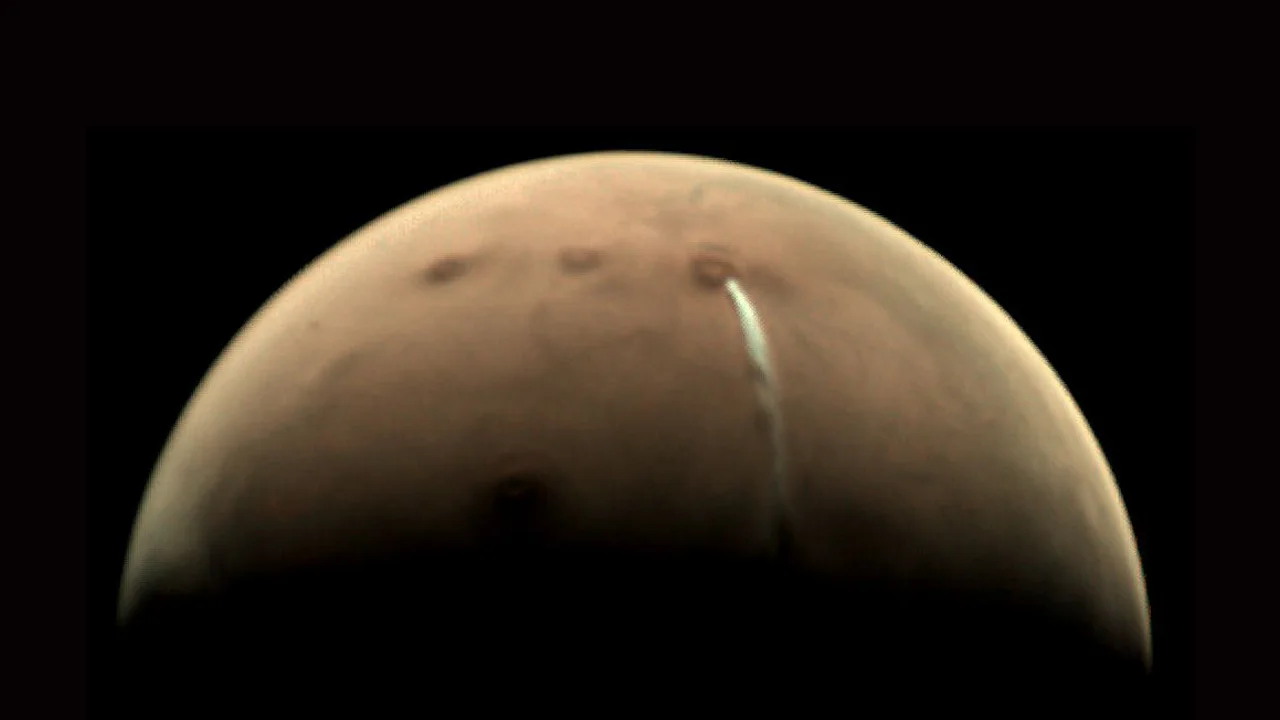
The mystery of this bizarre Mars cloud is beginning to unravel
The Arsia Mons Elongated Cloud is a strange recurring feature on Mars, and images from a satellite 'webcam' are revealing its secrets.
In recent years, images sent back from Mars have revealed a bizarre sight — an immense elongated cloud streaming away from one of the Red Planet's massive, extinct volcanoes. Scientists are now beginning to unravel the mysteries behind this strange weather pattern using The Mars Webcam, on board the ESA's Mars Express spacecraft.
Satellites in orbit around Mars have revealed some amazing details about the planet. However, by design, most confine themselves to a narrow view as they focus their high-resolution cameras at the surface. Studying some features of the planet, however, requires a broader perspective.
One such feature of note is the Arsia Mons Elongated Cloud.
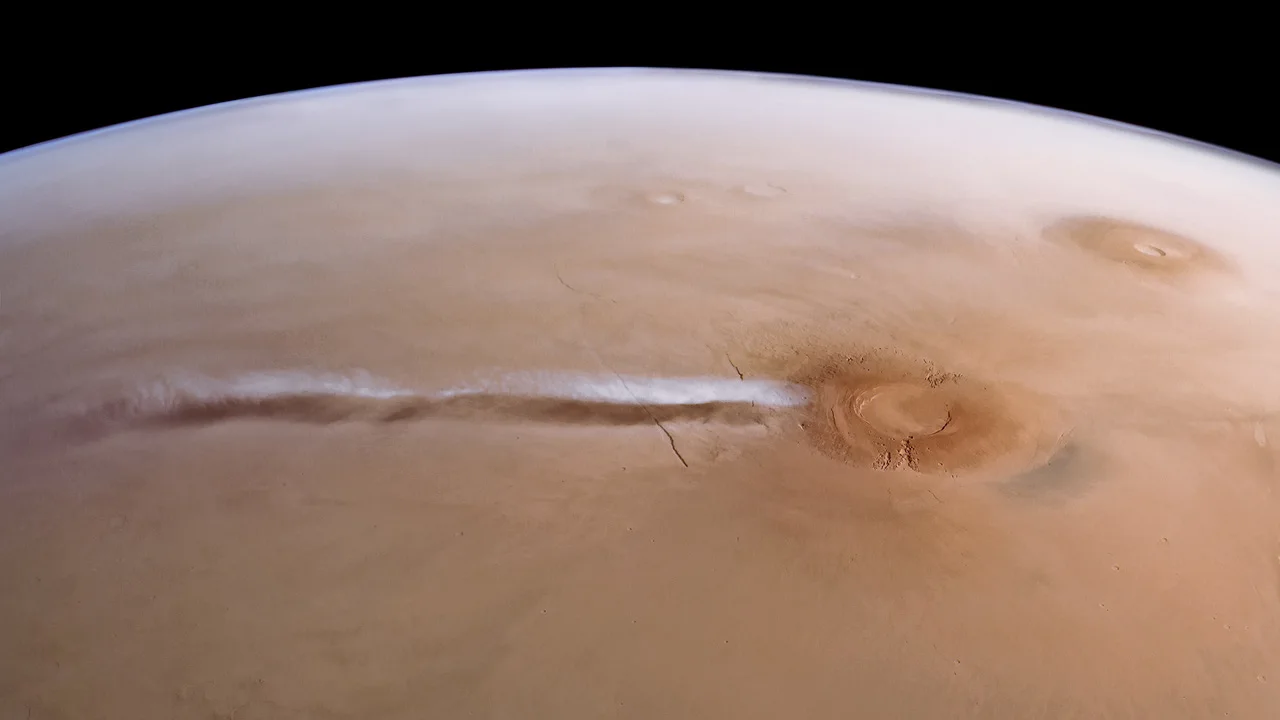
This closeup of the Arsia Mons Elongated Cloud, taken by Mars Express' High Resolution Stereo Camera on September 21, 2018, shows it from a perspective of about 7,000 km above the surface. Credit: ESA/DLR/FU Berlin/Justin Cowart, CC-by-2.0
The Arsia Mons Elongated Cloud, or AMEC, is an immense water-ice cloud that forms near Arsia Mons, a 20-km tall extinct volcano near Mars' equator. Spotted going back as far as the Viking missions in the mid-1970s, a new study using more recent observations has revealed the cloud's daily patterns and dynamics.
Forming daily over the span of a few months around each Martian winter solstice, the AMEC has been seen to stretch up to 1,800 kilometres long and from 150-250 kilometres wide. Although it may appear to be volcanic, it is actually an orographic cloud formed by warm, humid air flowing up a mountain's slopes.
Mars' atmosphere is extremely thin, and liquid water is virtually nonexistent on its surface. Even so, there is still enough humidity in the air to allow thin clouds to form.
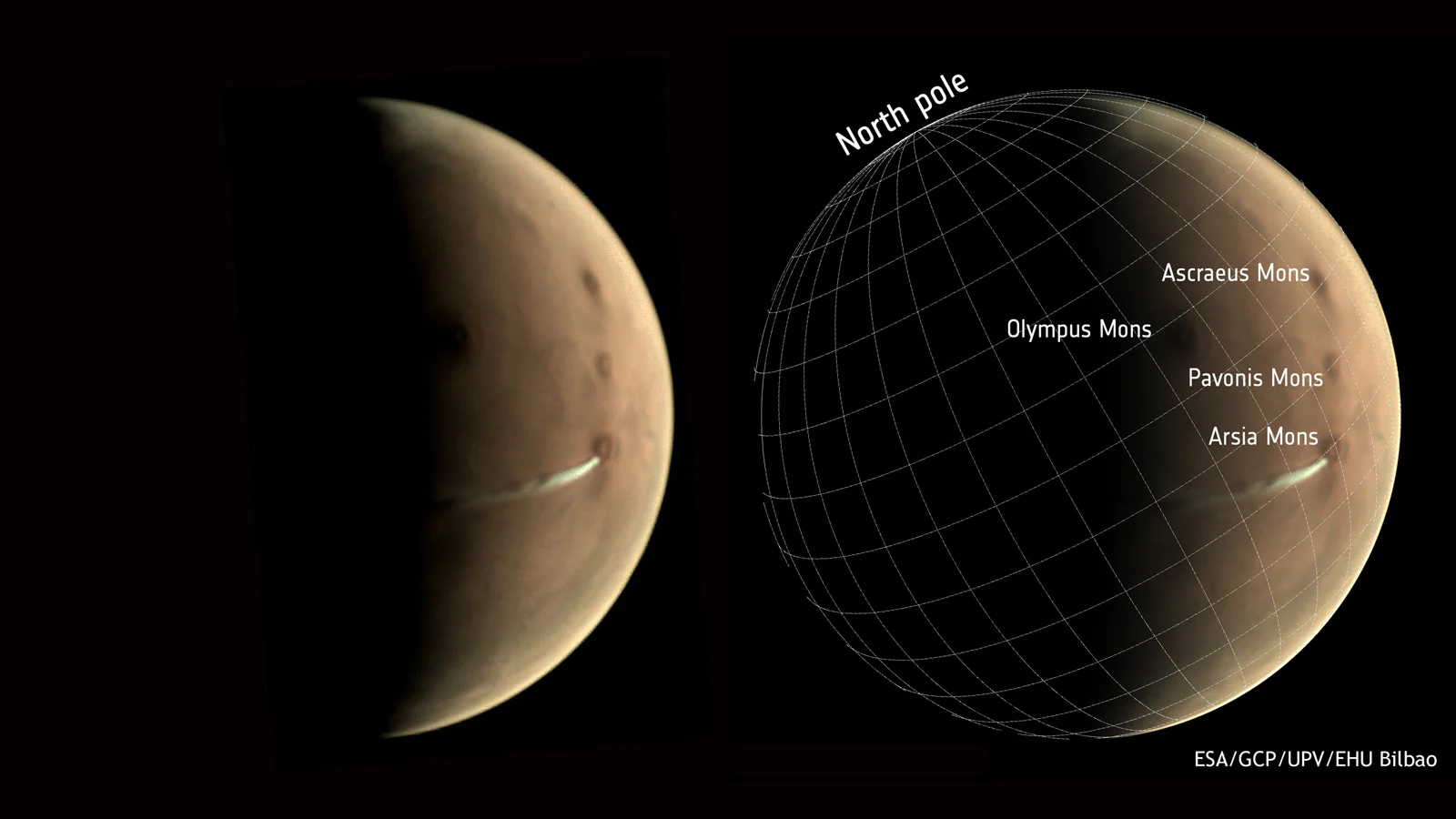
On the left, an image from the Visual Monitoring Camera (VMC) on board Mars Express, taken on October 10, 2018, clearly shows the AMEC streaming away from Arsia Mons. On the right, an annotated version labels the features seen in the image. Credit: ESA/GCP/UPV/EHU Bilbao
Although this feature has been spotted by a few different cameras on board various Mars-orbiting spacecraft, it's difficult for most of them to observe it regularly. Given their camera setups, unless commanded to do otherwise, these spacecraft typically snap their imagery near the middle of the Martian day (Sol) to minimize the effects of shadows.
However, by mid-Sol, the Arsia Mons Elongated Cloud is usually gone.
According to the ESA: "The cloud undergoes a rapid daily cycle that repeats every morning for several months. It begins growing before sunrise on the western slope of Arsia Mons before expanding westwards for two and a half hours, growing remarkably fast – at over 600 km/h – at an altitude of 45 km. It then stops expanding, detaches from its initial location, and is pulled further westwards still by high-altitude winds, before evaporating in the late morning as air temperatures increase with the rising Sun."
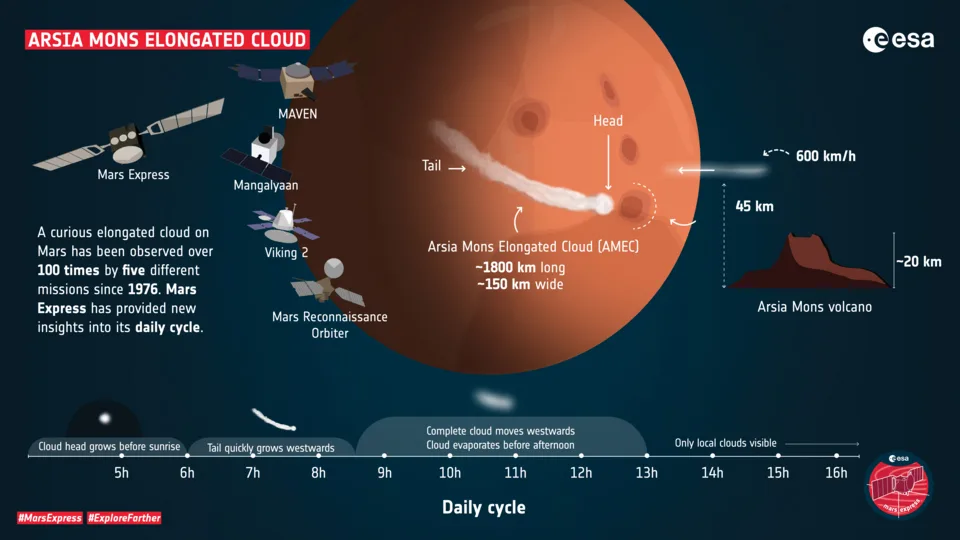
This infographic displays all the known details of the Arsia Mons Elongated Cloud's location and daily cycle. Credit: ESA
"Although orographic clouds are commonly observed on Earth, they don't reach such enormous lengths or show such vivid dynamics," study co-author Agustin Sánchez-Lavega, who is the Science Lead for the VMC at the University of the Basque Country, said in an ESA news release. "Understanding this cloud gives us the exciting opportunity to try to replicate the cloud's formation with models – models that will improve our knowledge of climatic systems on both Mars and Earth."
A WEBCAM FOR MARS SCIENCE
One remarkable aspect of this new study is that the images used to track the daily pattern of the AMEC were snapped by a camera that was never intended to be used for science.
The Visual Monitoring Camera (VMC) on Mars Express is similar to what an off-the-shelf webcam would have been like when the spacecraft was assembled, roughly 20 years ago.
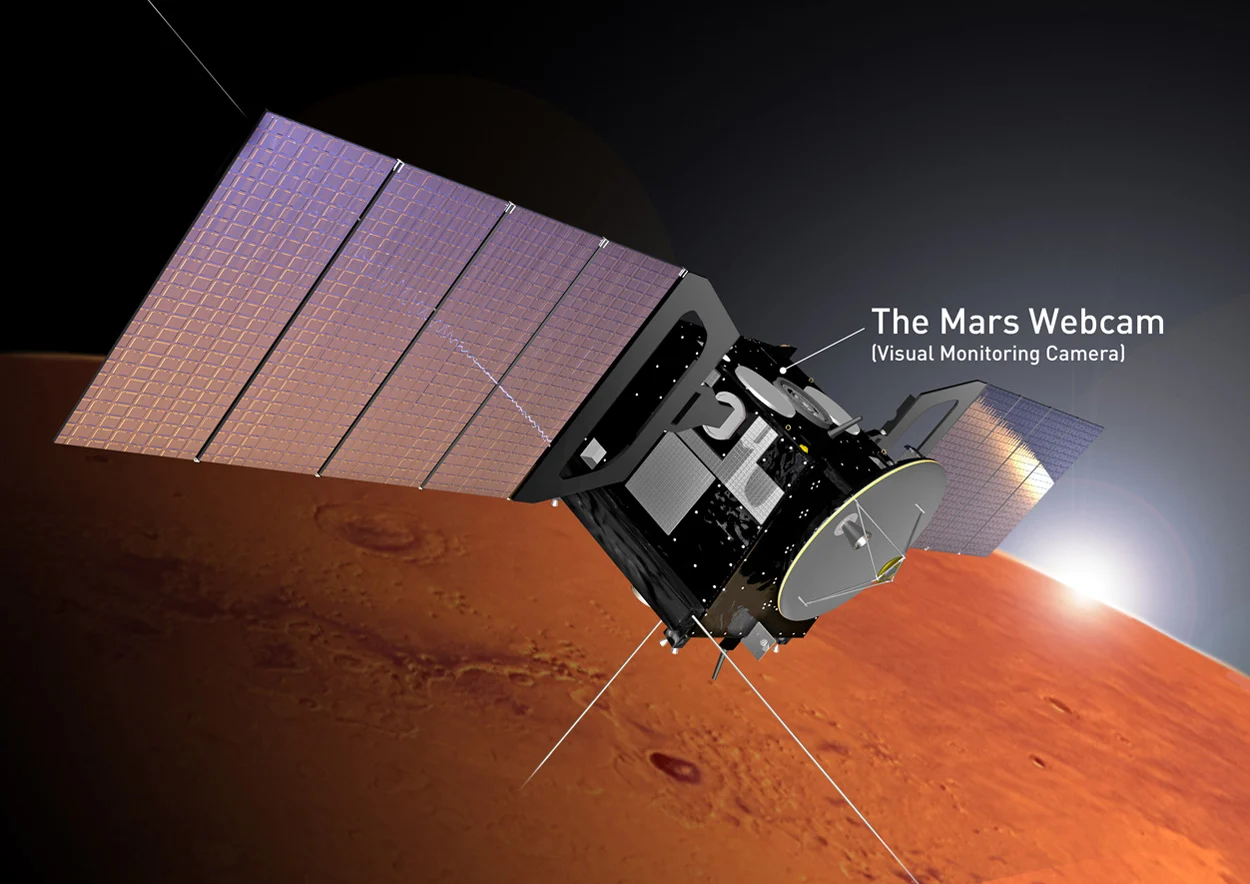
This artist impression of the Mars Express orbiter shows the location of the Mars Webcam (aka the Visual Monitoring Camera). Credit: ESA/Scott Sutherland
The VMC had one purpose when Mars Express arrived at the Red Planet in 2003. It provided the team back on Earth with direct visual confirmation that the Beagle 2 lander had detached from the orbiter and was on its way to Mars' surface. Although Beagle 2 ultimately did not land intact, VMC performed its job flawlessly and was subsequently shut down.
Four years later, the mission team turned it back on. Unofficially renamed the Mars Webcam, on each orbit of the planet, it took dozens of images which were then uploaded for everyone to see. While not showing off as much detail as its high-resolution science cameras, it was still a fantastic tool for public outreach.
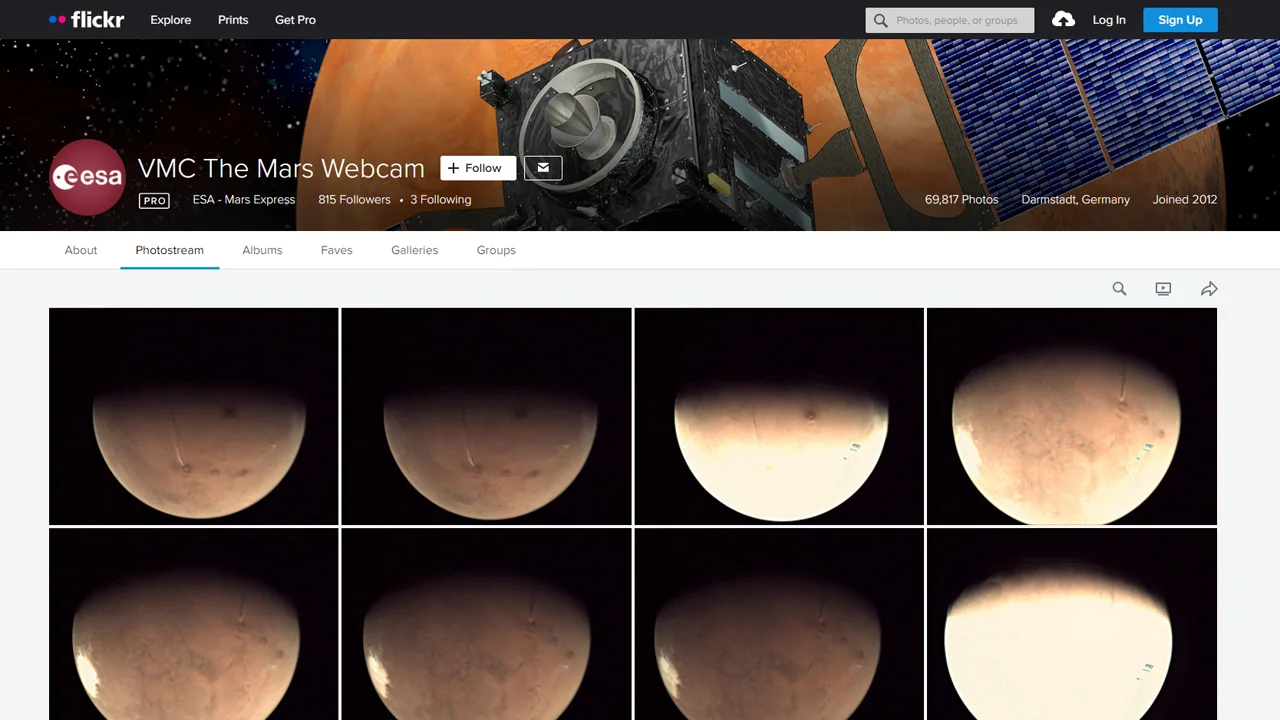
The Mars Webcam on Flickr. Image credits: ESA
"However, recently, the VMC was reclassified as a camera for science," Jorge Hernández Bernal of the University of the Basque Country, said in an ESA press release. Hernández Bernal, who studies Mars' climate using the VMC, is the lead author of this new study on the AMEC.
"Although it has a low spatial resolution, it has a wide field of view — essential to see the big picture at different local times of day — and is wonderful for tracking a feature's evolution over both a long period of time and in small time steps. As a result, we could study the whole cloud across numerous life cycles."
A MYSTERY STILL TO SOLVE
Although observations from Mars Express have revealed the Arsia Mons Elongated Cloud's daily patterns, there is still at least one big question left about this weather pattern.
According to the ESA, clouds are seen to form at the tops of all of Mars' volcanoes throughout most of the Martian year. In the months leading up to summer for Mars' southern hemisphere, all of these clouds disappear — except at Arsia Mons. It's at this time that the Arsia Mons Elongated Cloud appears and does so repeatedly, day after day.
"This cloud repeats every Martian year due to a delicate balance of conditions," Justin Cowart, a Ph.D. student at Stony Brook University who was not involved in the study, explains. "First, the south pole is approaching its summer equinox, and as it shrinks back the atmosphere becomes denser and more moisture-laden. Second, the atmosphere in the region of Arsia Mons is still in the process of warming up as Mars approaches the Sun. Third, the warming skies in the southern hemisphere start lofting dust, which provides small particles for water to condense onto."
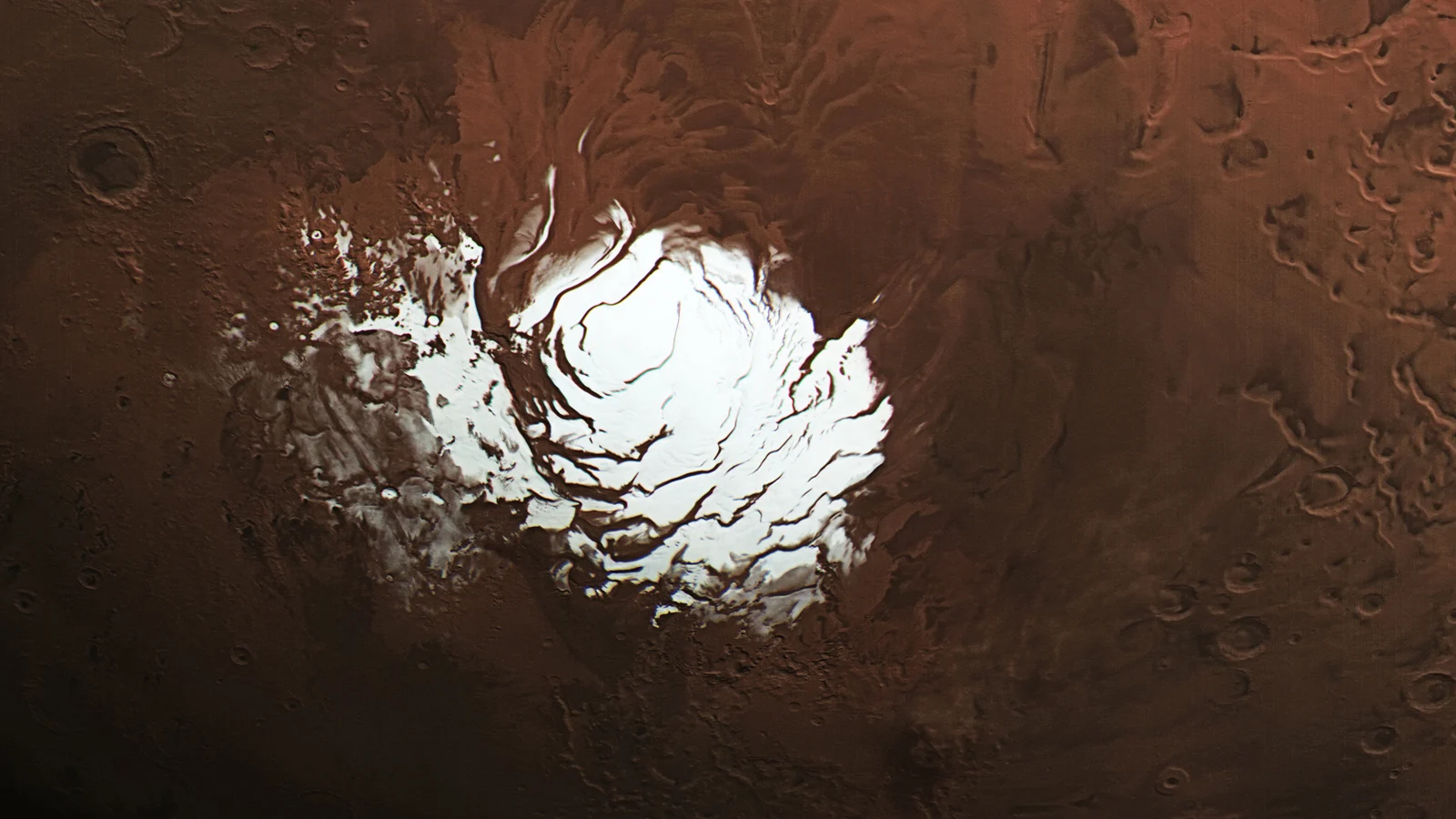
Mars' south polar ice cap, imaged by Mars Express' High Resolution Stereo Camera on February 25, 2015. Credit: ESA/DLR/FU Berlin
"The last condition is wind," Cowart, who studies Mars geology using orbital imagery, added. "Shortly after the Sun rises, winds start blowing west across the region. This wind pushes air up the eastern slope of Arsia Mons. The 20 km difference in elevation from base to summit causes the water to condense out as the air ascends and cools."
Although we can see how all of these factors add up to produce the AMEC, there is still one question left unanswered here. Why, with three volcanoes in close proximity to one another — Arsia Mons, Pavonis Mons, and Ascraeus Mons — plus Olympus Mons nearby as well, do we see this cloud formation associated only with Arsia Mons?
"This first study is mainly observational. In a second more theoretical study, we will try to understand in greater detail the formation of the cloud, which is formed by the interaction of the atmosphere with the slopes of the volcano," Hernández-Bernal said in a Tweet on Tuesday.











